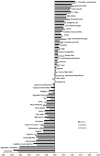Dietary patterns in the Avon Longitudinal Study of Parents and Children
- PMID: 26395343
- PMCID: PMC4586449
- DOI: 10.1093/nutrit/nuv055
Dietary patterns in the Avon Longitudinal Study of Parents and Children
Abstract
Publications from the Avon Longitudinal Study of Parents and Children that used empirically derived dietary patterns were reviewed. The relationships of dietary patterns with socioeconomic background and childhood development were examined. Diet was assessed using food frequency questionnaires and food records. Three statistical methods were used: principal components analysis, cluster analysis, and reduced rank regression. Throughout childhood, children and parents have similar dietary patterns. The "health-conscious" and "traditional" patterns were associated with high intakes of fruits and/or vegetables and better nutrient profiles than the "processed" patterns. There was evidence of tracking in childhood diet, with the "health-conscious" patterns tracking most strongly, followed by the "processed" pattern. An "energy-dense, low-fiber, high-fat" dietary pattern was extracted using reduced rank regression; high scores on this pattern were associated with increasing adiposity. Maternal education was a strong determinant of pattern score or cluster membership; low educational attainment was associated with higher scores on processed, energy-dense patterns in both parents and children. The Avon Longitudinal Study of Parents and Children has provided unique insights into the value of empirically derived dietary patterns and has demonstrated that they are a useful tool in nutritional epidemiology.
Keywords: ALSPAC; children; cluster analysis; dietary patterns; fruit and vegetables; obesity; pregnancy; principal components analysis; reduced rank regression.
© The Author(s) 2015. Published by Oxford University Press on behalf of the International Life Sciences Institute.
Figures


References
-
- Togo P, Osler M, Sørensen T, et al. Food intake patterns and body mass index in observational studies. Int J Obes Relat Metab Disord. 2001;25:1741–1751. - PubMed
-
- Quatromani PA, Copenhafer DL, D'Agostino RB, et al. Dietary patterns predict the development of overweight in women: the Framingham Nutrition Studies. J Am Diet Assoc. 2002;102:1239–1246. - PubMed
-
- Newby P. Are dietary intakes and eating behaviors related to childhood obesity? A comprehensive review of the evidence. J Law Med Ethics. 2007;35:35–60. - PubMed
-
- Kant AK. Dietary patterns and health outcomes. J Am Diet Assoc. 2004;104:615–635. - PubMed
-
- Newby PK, Tucker KL. Empirically derived eating patterns using factor or cluster analysis: a review. Nutr Rev. 2004;62:177 – 203. - PubMed
Publication types
MeSH terms
Grants and funding
LinkOut - more resources
Full Text Sources
Other Literature Sources

